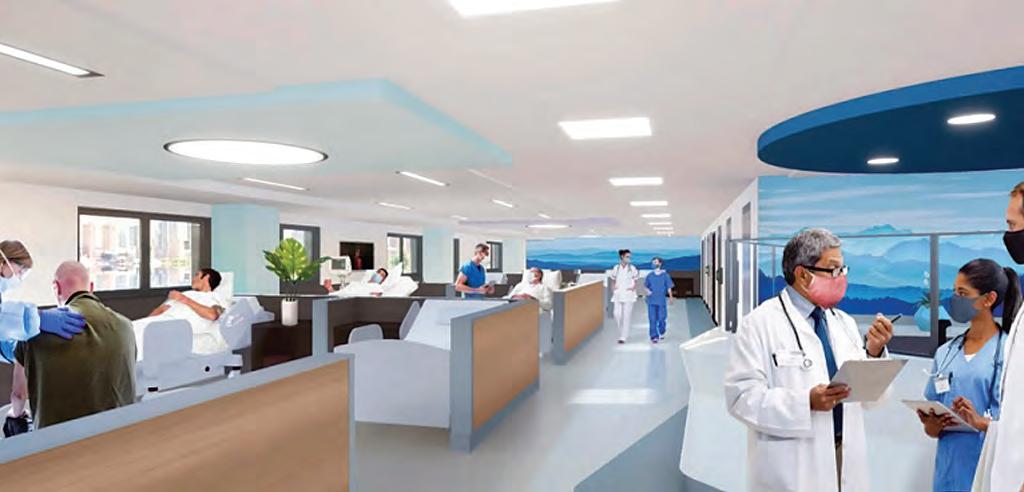
6 minute read
Council continues plans to close Rikers
by Naeisha Rose Associate Editor
Months after Mayor Adams raised concerns about plans to close the Big Apple’s largest jail complex for four smaller ones in Kew Gardens, Manhattan, Brooklyn and the Bronx, City Council Speaker Adrienne Adams (D-Jamaica) announced last Thursday the reappointment of the Independent Rikers Commission, a group tasked with seeing the initiative through within the next four years.
While the Speaker’s Office acknowledged that the city is delayed in erecting borough-based jails by the target goal because of the pandemic, the changing number of beds expected, the lack of treatment centers for those with serious health issues and the holdup of criminal cases in the court system, Councilwoman Carlina Rivera (D-Manhattan), chair of the Committee on Criminal Justice, is intent in ensuring that Rikers is closed by Aug. 31, 2027.
“Advocates, justice-impacted people, and the families of those who have died on Rikers all know the time is now to move the city forward to meet our legal requirement to open borough-based jails and close Rikers by 2027,” Rivera said in a statement. “Reducing the population is urgent, and we need as many voices as possible at the table to reiterate how important alternatives to incarceration, reentry services, and streamlined case processing are to our timeline. The revival of the Lippman Commission is critical to support the administration and state agencies in meeting this moral and legal mandate.”
The IRC is chaired by former state Judge Jonathan Lippman, who in 2017 revealed plans to build the smaller jails, which were expected to cost at least $8 billion.
“... the goal of Commission 2.0 is to take a renewed and realistic look at current on-the-ground conditions and find a safe, clear path to swiftly close Rikers,” Lippman said in a statement. “We are committed with all our energies to answering that call from Speaker Adams and Mayor Adams.”
The speaker said that she was proud to reappoint the IRC.
“It is clear that Rikers is not serving New Yorkers and continues to undermine public safety in our city,” she said in a statement.” Our commitment to meeting the legal mandate must be steadfast and will require the participation of all levels of government and parties involved in the criminal justice system.”
The mayor also says that he sup- ports the jail’s closure, so long as it maintains the dignity and safety for all justice-involved New Yorkers.
“... The pandemic also caused significant issues and delays with the previous administration’s plans to issue requests for proposals and implement the design-phase of the borough-based jails plan, as well as brought construction projects to a halt while causing costs to skyrocket,” he said in a statement. “Our administration’s commitment to the success of our jail system is unwavering, but we also have taken stock of the reality of how this once-in-a-generation pandemic impacted the original timeline for the implementation of the borough-based jail plan. The answer is not to ignore reality or compromise public safety, but to work together to find solutions ...”
Zachary Katznelson, a policy director for the commission, told the Chronicle via email that the projected cost is now roughly $10 billion.
“... I would note that whatever the projected total cost, the jails will be paid for with bonds,” Katznelson said. “Those bonds are paid back in annual installments over 30 years ... At the same time, we projected the City will save about $2 billion in annual operating costs once the borough jails are up and running. Therefore, we estimated the City would save about $1.3 billion per year by closing Rikers and moving to the borough jails — even after paying for the jails.”
The borough-based jails were once expected to hold 3,300 people when built, but are now slated to hold 4,160 beds with an additional 360 secure hospital beds elsewhere, according to Katznelson.
While there were 6,188 detainees as of Monday, the IRC believes the population can be reduced by speeding up court cases and diverting people who have substance abuse problems, alcohol addiction and mental, intellectual and developmental disabilities to beds at Correctional Health Services outside of Rikers.
At least 1,200 people who are detained are estimated to have a severe mental illness, according to the press release.
The city initially pledged to secure 250 beds at Bellevue, Woodhull and North-Central Bronx hospitals, but later increased the number to 400. So far, roughly 100 beds are partially built at Bellevue, which is 10 percent less than was hoped for, but that was a result of design concerns by the city Department of Correction and the State Commission on Correction, according to an IRC report from this month. Overall, none of the beds are open yet.
Moreover, the IRC believes because of the lack of tracking of people with serious illnesses at Rikers, the city should prepare to secure 1,500 beds at hospitals instead. The group also believes that state sites such as the Creedmoor Psychiatric Center in Queens Village and Kirby Forensic Psychiatric Hospital on Randalls Island should also be considered.
In addition, the commission wants waivers from the federal government to permit Medicaid to cover costs related to treatment in the units. Federal law generally bans the use of such funds for incarcerated people, but the IRC wants the state to ask to cover most treatment costs during the first and last 90 days a person is detained. It also wants treatment for incarcerated people who are under 21 and for former foster care youth who are up to age 26.
“New York has yet to apply for such a waiver, but California and Washington State recently had waiver applications approved so that Medicaid will cover many medical costs during the last 90 days before someone is released from jail or prison,” said Katznelson. Arizona, Kentucky, New Jersey, Utah and West Virginia have requests pending, he added.
Councilman Bob Holden (D-Maspeth) said via email that there is legislation before the Coun- cil to help the mentally ill.
“People with mental illness deserve proper treatment and care, not incarceration that could worsen their condition,” Holden said. “I strongly believe in expanding Kendra’s Law, enabling New York’s use of Medicaid for mental health and substance abuse treatments, and enhancing our mental health facilities and beds to serve this vulnerable population better.”
Holden also introduced bills Intro. 0793 and Res. 0088, one of which would require the Department of Health and Mental Hygiene to report on referrals to assisted outpatient treatment programs, while the other would call on Congress and the president to fully repeal the Institutions for Mental Diseases Exclusion from the Social Security Act, if signed into law.
“Building secure treatment beds within City hospitals is expected to cost 25% less than building jail beds,” said Katznelson. Boroughbased jail beds are projected to cost $660 million per year with the bond repayments.
The commission also raised concerns about the lack of mental health training among correctional officers and said that staffing is uneven.
In May, Rubu Zhao, a 52-year-old detainee, jumped to his death from a Program to Accelerate Clinical Effectiveness therapeutic unit at Rikers.
“All uniform staff are trained in suicide prevention at the Academy when they first join the Department,” said a DOC spokesman. “Every recruit receives 9 hours and 45 minutes of required New York State and DOC Suicide Prevention Training.”
Suicide Prevention is also a topic that is embedded in several other courses delivered to new-recruit officers such as Mental Illness Training, which is eight hours delivered by CHS and Mental Health First Aid, which is also eight hours. There is also an increase in the offerings for suicide prevention refreshers, teletypes are released weekly so that staff is aware of the training and the agency recently released a Self-Harm PSA video that is shown daily on internal DOC channels during roll call in the facilities. There also are posters on suicide prevention protocols, the spokesman said.
The DOC graduated a new class of officers on Oct. 13, and a new class was sworn-in on Oct. 19. A recruitment-filing period closed Oct. 16, the spokesman added.
CHS said it provides a continuum of mental healthcare, which is available in the jails, and patients in the general population can receive individual counseling that is akin to outpatient care. There is also a spectrum of therapeutic models for patients with serious mental, intellectual and other significant health needs.
The city Department of Design and Construction was not available to answer questions about what can be done to speed up construction on the jails in Kew Gardens, the Bronx and Manhattan. Community Board 13 was not available to answer questions on Creedmoor as a site for a potential CHS facility.
Alfred Brand, chairman of the Kew Gardens Civic Association, said the need for mental health and other services is critical, but the original Lippman Commission included no input from community leaders of the surrounding neighborhoods and the plan was “sprung” on the communities as a “done-deal” despite intense opposition.
“The Kew Gardens Civic Association is opposed to the current Borough Based Jails program,” he said. “The plan is fundamentally flawed. It will not meet the needs of the confined population or the people of the City of New York ... Objections were, and continue to be, ignored.” Q















